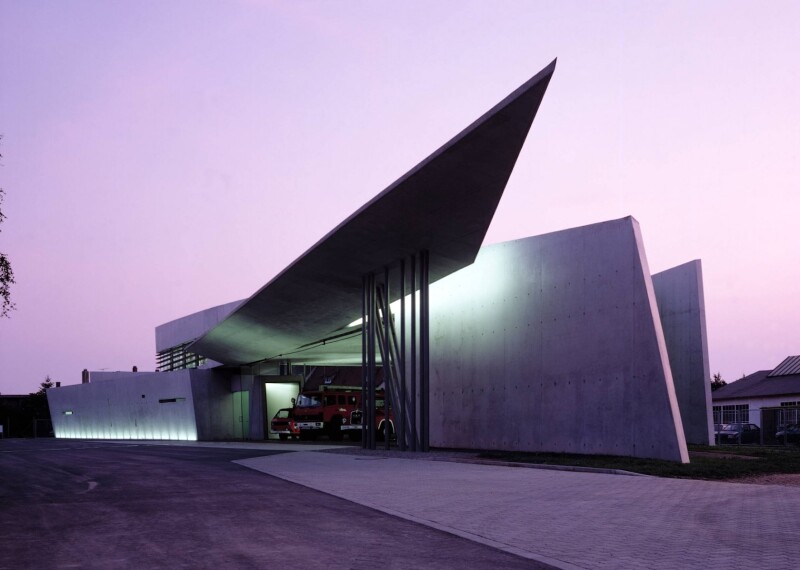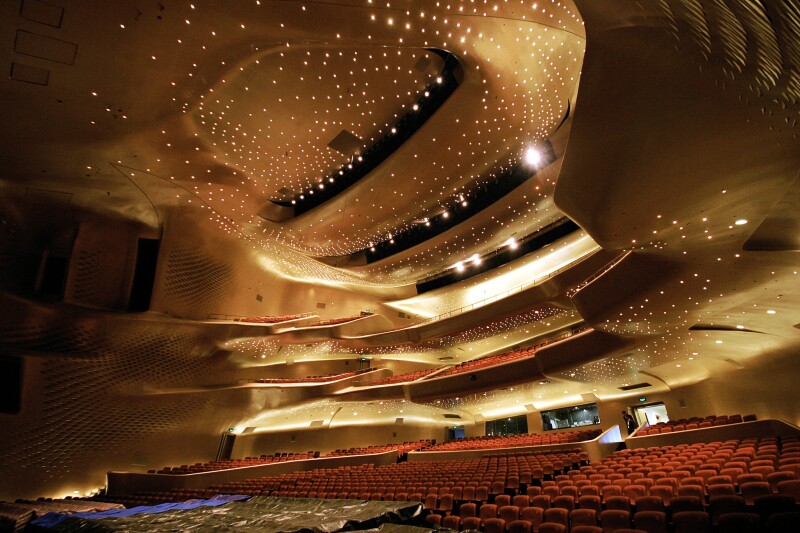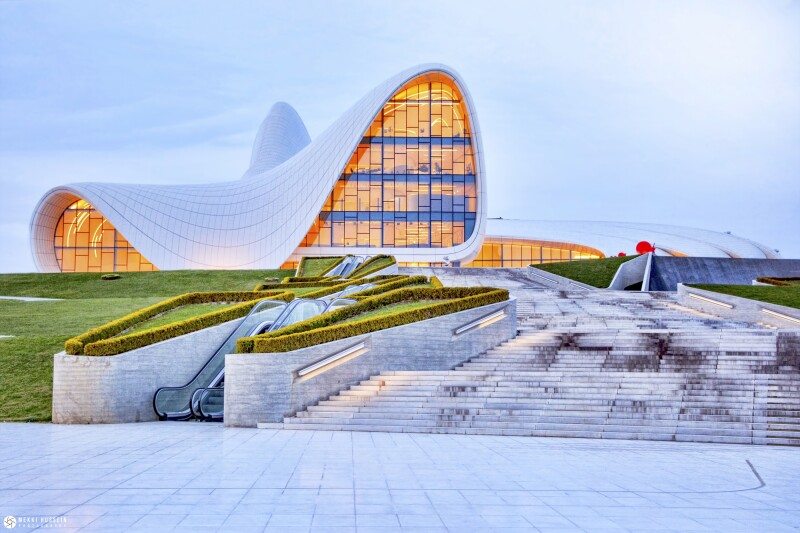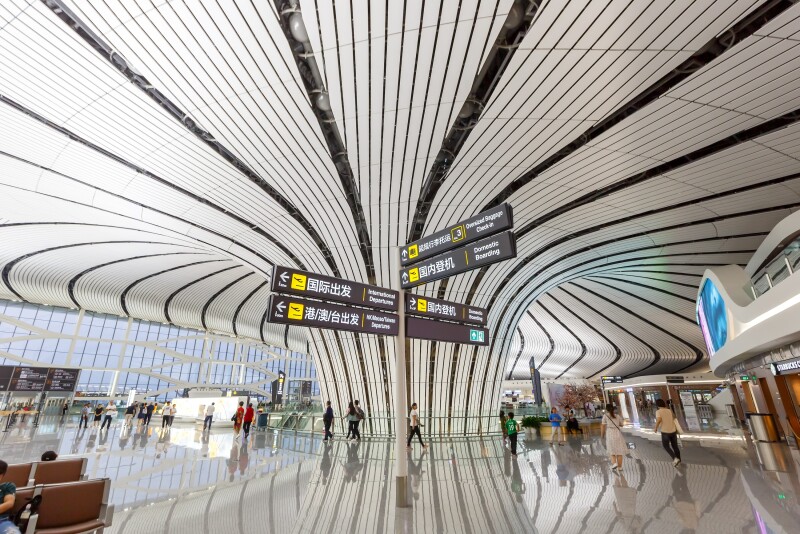Legendary architect Zaha Hadid is widely recognized for her futuristic buildings, constructed from steel, concrete, and glass and known for their impressive curves and geometric shapes. Hadid’s architectural innovations led to her nickname, “the Queen of the Curve,” one of many accolades Hadid earned throughout her nearly three-decade career.
Born in Baghdad, Iraq, in 1950, Hadid moved to London in 1972 to attend the Architectural Association School of Architecture, one of the world’s most competitive universities of architecture. There, she was awarded the prestigious Diploma Prize at her 1977 graduation, during which the famed Dutch architect Rem Koolhaus, who was one of Hadid’s professors at the university, described her as “a planet in her own orbit.” After graduating from the esteemed architecture school, the British Iraqi architect founded her own firm, Zaha Hadid Architects in 1979.
In 2004, Hadid became the first woman to win the Pritzker Architecture Prize, an annual international award often referred to as “the Nobel Prize of architecture.” In 2010 and 2011, Hadid received the Stirling Prize, awarded annually by the Royal Institute of British Architects (RIBA) for “excellence in architecture.” And in 2016, Hadid was the first woman to win the RIBA Gold Medal, which recognizes an individual’s substantial contributions to international architecture on behalf of the British monarch.
Sadly, Hadid died from a heart attack that same year, leaving behind multiple unfinished projects. Many have been brought to completion by her eponymous architecture firm, which continues to operate out of London and Beijing.
Now, nearly a decade later, we look back at some of the most iconic buildings that she designed—all worthy of a visit—from her first building in Germany to the Beijing Daxing International Airport.

The Vitra Fire Station was the first building Hadid was commissioned to design in 1993.
Photo by Christian Richter/Courtesy of Zaha Hadid Architects
Vitra Fire Station
- Where: Weil am Rhein, Germany | Find on Google Maps
- When: Daily 10 a.m.–6 p.m.
Located in Weil am Rhein, a small town near Germany’s borders with Switzerland and France, the Vitra Fire Station was Hadid’s very first building, completed in 1993. Hadid was commissioned to design it for a fire brigade on the Vitra Campus after a major 1981 fire destroyed most of the complex, which originally consisted of factory buildings but is now a collection of contemporary design and architecture showrooms. (Renowned architects including Frank Gehry, Tadao Ando, and Álvaro Siza also designed facilities for the site as part of the major rebuild.)
The Vitra Fire Station’s sharp, angular concrete planes garnered international acclaim for Hadid, putting her name and architectural style on the global map. The structure housed fire engines as well as showers, changing rooms, and a kitchenette for fire fighters. Today, however, its rooms are used for events and exhibitions held by the Vitra Design Museum, located within the complex.
Where to stay
- Book now: Grand Hotel Les Trois Rois
Weil am Rhein is fairly small, so opt instead to stay in Basel, Switzerland, 30 minutes away by train. For Old World luxury, book at Belle Époque beauty the Grand Hotel Les Trois Rois. The 101-room hotel, which has hosted Napoleon, Empress Michiko of Japan, and Picasso, sits on a bank of the Rhine and features period velvet furniture, wedding-cake plaster ceilings, and chiseled stone terraces.

Hadid’s first building in the United States: the Lois and Richard Rosenthal Center for Contemporary Art
Photo by cdschock/Flickr
Contemporary Arts Center
- Where: Cincinnati, Ohio | Find on Google Maps
- When: Thursday and Friday 10 a.m.–7 p.m; Saturday and Sunday 10 a.m.–4 p.m.
The Contemporary Arts Center was founded in 1939 as one of the first U.S. institutions dedicated to contemporary visual arts. In 2003, the CAC moved to a new downtown location designed by Zaha Hadid, the Lois and Richard Rosenthal Center for Contemporary Art. The Cincinnati museum, Hadid’s first building in the United States, was also the first American art museum designed by a woman. When the structure debuted, the New York Times called it “the most important American building to be completed since the end of the Cold War” because of its architectural innovation.
Across the seven floors of the museum (reminiscent of a Rubik’s cube, albeit taller and slimmer), gallery spaces made from concrete and metal vary in shape, length, and ceiling height and feature different lighting conditions to create what Hadid described as a “jigsaw puzzle” of diverse exhibition spaces. Within the building, black steel staircases connect irregularly shaped galleries that are stacked above a ground-level lobby that’s open to the public to use as a communal square.
Where to stay
- Book now: 21c Museum Hotel Cincinnati
No hotel is more fitting for a visit to this temple of contemporary art than the museum’s neighbor, 21c Museum Hotel Cincinnati. The red-brick century-old Metropole Hotel now has 156 rooms with tile from local producer Rookwood Pottery Company, gauzy curtains, and comfortable workstations. And the hotel has its own contemporary art collection, including several site-specific installations, such as Astrid Krogh’s fiber-optic tapestry.

The National Museum of the 21st Century Arts (MAXXI) won the Stirling Prize for Architecture after the museum opened in Rome in 2010.
Courtesy of Zaha Hadid Architects
MAXXI: National Museum of 21st Century Arts
- Where: Rome, Italy | Find on Google Maps
- When: Tuesday–Sunday 11 a.m.–7 p.m.
Zaha Hadid Architects successfully elevated Rome’s classical architecture foundation with this progressive contemporary art museum, which opened in 2010 after a decade-long construction process. Built on the site of a former military compound, the National Museum of the 21st Century Arts (MAXXI) won the 2010 Stirling Prize for Architecture, which is awarded annually by the Royal Institute of British Architects. According to Hadid’s architecture firm, the concrete and steel structure was created “not [as] an object-container, but rather a campus for art.” Notable features include curved walls, suspended black staircases, and open ceilings with thin concrete and glass beams that filter natural light onto the museum’s works of art.
Where to stay
- Book now: Hôtel Locarno, Roma
A stone’s throw from the Tiber and just outside Villa Borghese is the Piazza del Popolon neighborhood’s art deco Hôtel Locarno, which opened in 1920. Its 49 guest rooms are filled with antique furniture, damask wallpaper, and ornate chandeliers that lend it a yesteryear vibe. The hotel is a 35-minute walk from MAXXI, or 20 minutes on the tram.
Related: These Are the 21 Best Luxury, Boutique, and Historic Hotels in Rome

The main auditorium of the Guangzhou Opera House features a gypsum-paneled ceiling decorated with thousands of tiny lights that glisten like stars at night.
Photo by Virgil Simon Bertrand / Courtesy of Zaha Hadid Architects
Guangzhou Opera House
- Where: Guangzhou, China | Find on Google Maps
- When: Check the Guangzhou’s Opera House’s website for upcoming performances
This grandiose opera house in Guangzhou—an hour northwest of Hong Kong by train—opened in 2010 using the plans for the Cardiff Bay Opera House in Wales, which was never built. The Guangzhou Opera House, “the double pebble,” resembles two small rocks on the banks of the Pearl River, where the building is situated.
In addition to its dramatic 350-seat “multifunctional” hall used for performance art and concerts, the Guangzhou Opera House has a 1,687-seat main auditorium lined with panels made of molded glass-fiber reinforced gypsum. According to Zaha Hadid Architects, these panels are intended to give the opera hall’s interior a “fluid” and “seamless” appearance. Within the massive auditorium, the ceiling is lined with thousands of tiny lights resembling stars that shimmer as the lights dim.
Where to stay
- Book now: Ritz-Carlton, Guangzhou
Renovated in 2021, the Ritz-Carlton, Guangzhou occupies the 20th–38th floors of a tower only steps from the Pearl River. All 351 rooms and suites—complete with marble bathrooms, feather beds, and walk-in closets—have views of either the water or the bustling cityscape below. The outdoor pool is a luxurious respite during the steamy months in this southern Chinese city.
Related: I’ve Been to Guangzhou a Dozen Times, but This Last Trip With My Son Changed Me

The London Aquatics Center served as one of the main venues for the 2012 Summer Olympics and Paralympics.
Photo by Hufton + Crow/Courtesy of Zaha Hadid Architects
London Aquatics Centre
- Where: London, England | Find on Google Maps
- When: Daily 6 a.m.–11 p.m.
Hadid designed this sprawling indoor swimming facility in 2004, the year before London won the bid to host the 2012 Summer Olympics and Paralympics. After it was completed in 2011, the London Aquatics Centre went on to serve as one of the main venues for swimming, diving, and synchronized swimming during the 2012 competitions.
Situated within Queen Elizabeth Olympic Park in London’s East End, the venue is now open to the public for general use. It features two Olympic-size swimming pools, a 164-foot diving pool with platform heights from 3 to 32 feet, a 100-station gym with changing facilities, plus a café and other communal areas. The center was inspired by the fluidity of moving water and has what Hadid’s firm calls an “undulating roof that sweeps up from the ground as a wave.” On the ceilings and walls, 628 glass panes let natural light into the main pool areas.
Where to stay
- Book now: The Ned
A 20-minute tube ride from the Aquatic Centre in the City (London’s financial district) is the Ned, a 1920s bank building turned hotel/member’s club. The property sports a cool, vintage-inspired design. The 250 guest rooms range in category from small Crash Pad and Cosy to spacious Heritage rooms with canopy beds. All have 1920s flair: wingback chairs, Jazz Age motifs, and mirrored cocktail cabinets, plus marble-mosaic bathrooms with rain showers and Cowshed products.

The Riverside Museum’s zinc-clad rooftop towers in a zigzag formation above the River Clyde in Glasglow.
Photo courtesy VisitScotland/Kenny Lam
Riverside Museum
- Where: Glasgow, Scotland | Find on Google Maps
- When: Daily 10 a.m.–5 p.m.
Hadid had been living and working in the United Kingdom since the early 1970s, but her first major U.K. commission didn’t debut until 2011 when the Riverside Museum opened in Glasgow. The glass facade building houses more than 3,000 items that span the Scottish city’s transport, engineering, and shipbuilding legacy, with formerly used train cars, cars, bikes, and even skateboards on display in its galleries. The zinc-clad roof of the Z-shaped museum towers approximately 85 feet above Glasgow’s River Clyde, forming a complex series of paneled ridges that zigzag across the top of the tunnel-like building, designed to symbolize the connection between the city and its waterfront.
Where to stay
- Book now: Kimpton Blythswood Square Hotel & Spa
In a handsome Georgian building from the 1820s, with a pretty private garden, are 113 rooms with marble baths, cushioned headboards, soft globe lights, and thick drapes to keep out the Scottish chill.
Related: This Crowd-Free Scottish City Offers Buzzy Restaurants, Free Museums, and Shaggy Highland Cows

The Galaxy SOHO complex in central Beijing consists of four spherical structures connected by curving platforms, courtyards, and pedestrian bridges, with 18 floors total.
Photo by Iwan Baan/Flickr
Galaxy SOHO
- Where: Beijing, China | Find on Google Maps
- When: Anytime of day
The Galaxy SOHO is an office, retail, and entertainment complex in central Beijing. Completed by Zaha Hadid Architects in 2012, the impressive building—made from slabs of reinforced concrete, aluminum, stone, glass, and stainless steel—was inspired by the grand scale of China’s capital city. The entire complex is completely devoid of corners, featuring a design that reflects traditional Chinese architecture, the type found in Beijing’s hutongs, where connected courtyards create a maze of open spaces. The canyon-like layout consists of four spherical structures connected by curving platforms, courtyards, and pedestrian bridges; 3 of the 18 floors are below ground.
Where to stay
- Book now: The PuXuan Hotel and Spa
A 20-minute walk from Tiananmen Square and the entrance to the Forbidden City is the PuXuan Hotel and Spa, an oasis of 116 peaceful rooms. Each comes with a well-stocked complimentary minibar, blinds and curtains that close at the touch of a button, and a lounge area with a sofa, table, and chairs.

The Heydar Aliyev Center in Baku, Azerbaijan, was designed as a symbol of the country’s modernization and independence from the Soviet Union.
Photo by Iwan Baan / Courtesy of Zaha Hadid Architects
Heydar Aliyev Center
- Where: Baku, Azerbaijan | Find on Google Maps
- When: Tuesday–Friday 11 a.m.–7 p.m., weekends 11 a.m.–6 p.m.
Situated in the heart of Baku, Azerbaijan, this eye-catching cultural center was built by Zaha Hadid Architects in 2012 to symbolize modernization and development in the country after it gained independence from the Soviet Union in 1991. When the Heydar Aliyev Center debuted, the shell-like building attracted attention for the way it purposefully stands in contrast with the rigid Soviet architecture that’s still prevalent in the capital. It also amassed some controversy surrounding its name, taken from Azerbaijan’s former president who led the country from 1993 to 2003 and was described by some as authoritarian.
The cultural venue is set on a public plaza on Heydar Aliyev Boulevard, a main throughway in Baku that connects the international airport to the old city. The undulating building features exhibition spaces, a library, a museum, and concert venues where a rotating program of art exhibitions, performances, conferences, and workshops showcase Azeri history and contemporary culture, both local and international. But some of the displays aren’t temporary: Artworks by such renowned artists as Anish Kapoor and Yayoi Kusama are permanently on view.
Where to stay
- Book now: Four Seasons Hotel Baku
Overlooking a bay in the Caspian Sea is the Four Seasons Hotel Baku, housed in a magnificent Beaux-Arts-style building. The 171 rooms have marble bathrooms, wingback chairs, and balconies with views of either the Caspian or Baku’s Old City, which is a UNESCO World Heritage site.

Because of its unique design, the Eli and Edythe Broad Art Museum at Michigan State University appears to change its appearance as visitors move about its interiors.
Photo by Snehit Photo/Shutterstock
MSU Broad Art Museum
- Where: East Lansing, Michigan
- When: Wednesday–Sunday 10 a.m.–6 p.m.
Located on Michigan State University’s collegiate Gothic north campus in East Lansing, the MSU Broad Art Museum sits in cool, minimalist contrast to the red brickwork buildings that surround it. The museum has three stories—two above-ground levels and a basement—and features a striking pleated facade of stainless steel and glass. Hadid intended for the structure to blend seamlessly with its surroundings. And the unusual series of windows created by the pleats of steel are meant to change guests’ perception of the building as they move about its interiors.
Completed in 2010, the 46,000-square-foot building was named after philanthropists and avid art enthusiasts Eli and Edythe Broad, who have amassed a wealth of contemporary and postwar art during four decades of collecting. Some of the most memorable spaces in the museum include its a double-height gallery, where large windows let in plenty of natural light and create an atmosphere that feels spacious and modern.
The more than 10,000 works in the museum’s permanent collection include Greek and Roman antiquities, pre-Columbian sculpture, and European and American prints, photographs, and paintings. The museum is showcasing the work of Hadid’s design studio, Zaha Hadid Designs, through August 2026. Admission to the museum is free, although ticket reservations are required.
Where to stay
- Book now: Wild Goose Inn
Just across from MSU’s campus, five minutes’ walk from the Broad Museum, is this bed-and-breakfast: Wild Goose Inn. Each of the six rooms has a fireplace, Jacuzzi, and thoughtful touches like fresh flowers and candles. The enticing breakfast spread includes French toast, eggs, and oatmeal and can be enjoyed in the dining room or on the patio.

The Beijing Daxing International Airport is also known as “the starfish” because of its unique shape and five “arms.”
Photo by Markus Mainka/Shutterstock
Beijing Daxing International Airport
- Where: Beijing, China
- When: Anytime
Completed in 2019, Daxing International Airport (PKX) was still being built at the time of Hadid’s death and replaced the 109-year-old Nanyuan Airport (35 minutes north of Daxing), Beijing’s first airport.
The four-story building was intended to help alleviate air traffic congestion in the city and span 79 gates in the main terminal hall. The airport has been nicknamed the “starfish” because of its unique shape—it has five concourses, its arms, that all link up to a main hall. The unique design ensures that anyone can reach the furthest gate at the end of a concourse within an eight- minute walk. Daxing International Airport is also conveniently connected directly to China’s high-speed railways as well as local Beijing trains, making access to the airport easy. Hadid designed a rainwater collection and a water management system, which stores and purifies water from local wetlands and helps prevent flooding.
All of its sprawling space will come in handy because the number of passengers at PKX is expected to grow to 72 million per year, with a planned expansion before 2040 to serve up to 100 million people annually and process 4 million tons of cargo. It’s one of two international airports that service the Beijing area. (Beijing Capital International Airport is more centrally located to the city.)
Where to stay
- Book now: Waldorf Astoria Beijing
Well-positioned for exploring Beijing’s hutongs, a maze of alleyways lined in traditional courtyard houses, the Waldorf Astoria Beijing is also walking distance to pedestrian shopping street Wangfujing. The 176 rooms make nice use of color—sage green walls, peach velour benches—plus separate lounge areas with an armchair and roomy desk.
This article was originally published in 2019 and most recently updated on September 9, 2025, with current information.











